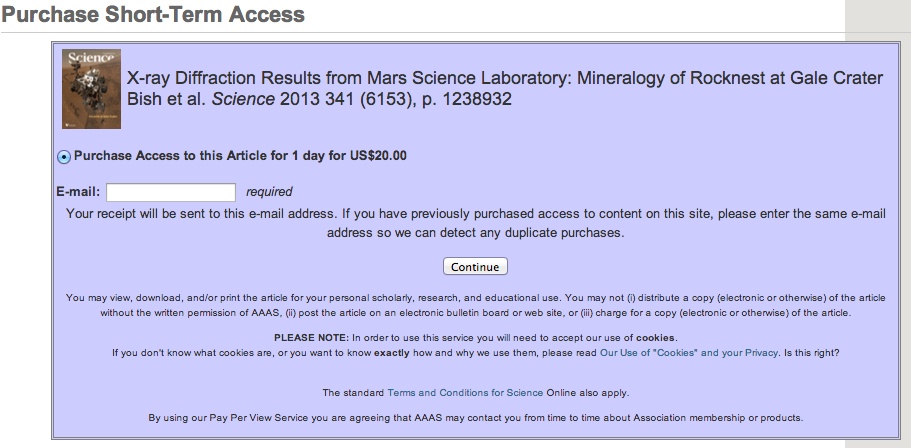The Mars Curiosity rover has been a huge boon for NASA – tapping into the public’s fascination with space exploration and the search for life on other planets. Its landing was watched live by millions of people, and interest in the photos and videos it is collecting is so great, that NASA has had to relocate its servers to deal with the capacity.
So what does NASA do to reward this outpouring of public interest (not to mention to $2.5 billion taxpayer dollars that made it possible)? They publish the first papers to arise from the project behind a Science magazine’s paywall:
There’s really no excuse for this. The people in charge of the rover project clearly know that the public are intensely interested in everything they do and find. So I find it completely unfathomable that they would forgo this opportunity to connect the public directly to their science. Shame on NASA.
This whole situation is even more absurd, because US copyright law explicitly says that all works of the federal government – of which these surely must be included – are not subject to copyright. So, in the interests of helping NASA and Science Magazine comply with US law, I am making copies of these papers freely available here:
- Stolper et al. The Petrochemistry of Jake_M: A Martian Mugearite
- Meslin et al. Soil Diversity and Hydration as Observed by ChemCam at Gale Crater, Mars
- Bish et al. X-Ray Diffraction Results from Mars Science Laboratory: Mineralogy of Rocknest at Gale Crater
- Blake et al. Curiosity at Gale Crater, Mars: Characterization and Analysis of the Rocknest Sand Shadow
- Leshin et al. Volatile, Isotope, and Organic Analysis of Martian Fines with the Mars Curiosity Rover
Update: Copyright
For those interested in the issue of copyright in works of the US government, please see the following:
Section 105 of US Copyright Act, which states:
Copyright protection under this title is not available for any work of the United States Government, but the United States Government is not precluded from receiving and holding copyrights transferred to it by assignment, bequest, or otherwise.
House Report 94-1476 which details the reasoning behind this provision:
The effect of section 105 is intended to place all works of the United States Government, published or unpublished, in the public domain. This means that the individual Government official or employee who wrote the work could not secure copyright in it or restrain its dissemination by the Government or anyone else, but it also means that, as far as the copyright law is concerned, the Government could not restrain the employee or official from disseminating the work if he or she chooses to do so. The use of the term “work of the United States Government” does not mean that a work falling within the definition of that term is the property of the U.S. Government.
The only ambiguity in the case of these Curiosity papers is that not all of the authors are US Government employees, and thus the work is, I am told “co-owned” by the authors. I’m not sure what effect this has on the ability of Science magazine to assert copyright in the work, since, at best, they are doing so at the behest of only a subset of the authors. The law makes it clear that its intent is to direct the US government authors to place the work in the public domain, and that any agreement they enter into to restrict access to the work is invalid. This is why I view the practice of taking works authored (and funded) by the US government and placing them behind paywalls to be illegitimate.
Update 2: JPL has now posted the articles on their site
As of today these articles are now available to download from the JPL website. I assume this was done in response to this post and the attention it received. (They were not there on the 26th when the press releases went out – I looked. And you can see from the PDFs that they weren’t downloaded from the Science website until the 27th.) Let’s hope that in the future that all NASA papers – and indeed the results of all government funded research – are made immediately freely available.

3 Comments